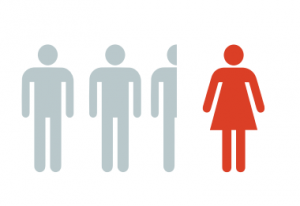At this point it’s fairly well known that women are routinely underrepresented – and misrepresented – in major motion pictures. But we’d like to believe that in this modern era of equality, things are finally changing for the better. Not so, says the USC Annenberg Media, Diversity, & Social Change Initiative’s latest report.
this point it’s fairly well known that women are routinely underrepresented – and misrepresented – in major motion pictures. But we’d like to believe that in this modern era of equality, things are finally changing for the better. Not so, says the USC Annenberg Media, Diversity, & Social Change Initiative’s latest report.
The report, Gender Inequality in Popular Films, is the most recent in a seven-year series on the topic that has produced, according to FiveThirtyEight, “the single-most comprehensive set of statistics about women and minorities in film.”
The report finds, among other things, that out of 4,506 speaking and named characters in the top-grossing movies of 2013, less than 30% were female. The disparity was greatest in action and adventure films, where less than 24% of characters were female. Women faired even worse behind the camera; less than 16% of 2013 content creators were female, and the majority of them were producers (19.6% women) as opposed to writers (7.4%) or directors (less than 2%).
But perhaps more alarmingly, the report compared this year’s findings to those of the last six years (with the exception of 2011) and found that none of these statistics have increased significantly in that time period. In other words, women are just as underrepresented in Hollywood today as they were six years ago, despite ongoing efforts to call attention to the problem and promote greater opportunities for women in film. In fact, the report notes, “the number of female directors and writers is at a six‐year low.”
This result is quantitative proof that “the lack of female characters does not appear to be a problem that will self‐correct over time.” It is real evidence that nothing will change unless we step in and make those changes ourselves.
One way to start might be to focus on increasing the number of women behind the camera. According to the study, films with female producers were less likely to engage in the hypersexualization of female characters, suggesting that “adding women behind the scenes may contribute to real differences in how females are portrayed.” So if we want to see more gender-balanced casts onscreen, we need to start creating more opportunities for women behind the scenes.
Visit the Media, Diversity, & Social Change Initiative’s website to read the full report. If you’re in DC and want to know more, check out the programs and resources offered by Women in Film & Video. Outside DC? Find your local Women In Film & Television affiliate here!
